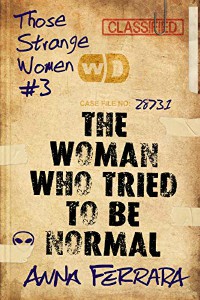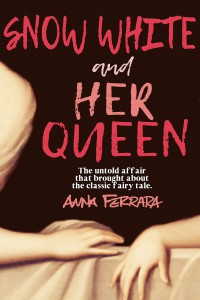I read a very great deal, but I’m kind of like a butterfly; while there are some things which will always draw my attention the most, I flit around quite a bit otherwise. When The Woman Who Tried to Be Normal landed in my inbox, I was intrigued to see that its protagonist was a synesthetic woman. I freely admit that I opened it strictly on that basis alone.
Tag Archives: Anna Ferrara
Mary Springer reviews Snow White and Her Queen by Anna Ferrara
Trigger Warning: the book contains scenes of suicide, rape, and assault and this review will discuss them.
This review contains spoilers.
Katherine was married to the King of the Northern Kingdom when she was thirteen. Seventeen years later, she plans to kill herself, but she is saved by a beautiful young woman. Soon she finds out this beautiful woman, only seven years younger than her, is her stepdaughter, Eirwen, also known as Snow White. What follows is a tumultuous love story and retelling of a classic fairy tale with a unique twist.
I have had a difficult time gathering my thoughts on this book. To be clear, I did enjoy reading this. However, there are several elements that I’m having a hard time reconciling with my enjoyment. Katherine married King Ferdinand when she was thirteen, a mere child. When we first are introduced to her as an adult it is through a graphic scene in which she has painful sex with Ferdinand. He is angry with her for not getting him a child after so many years of marriage. Katherine, believing him to be a good man and her to be a bad wife for not getting pregnant, then decides to kill herself in the garden. This is where she meets Eirwen. Later on, Ferdinand tells her to get a hobby, specifically hunting, and there she meets Phillip. Phillip decides he is in love with her and won’t take no for an answer. Eventually, this leads to him sexually assaulting her.
Another hard part about reading this is how the two men were supported and even enabled by those around them, men and women. Ferdinand blames Katherine for all his misdeeds, which is what causes her to be known as the Evil Queen. He has effectively isolated her from any support, including her own ladies-in-waiting who gossip about her behind her back. This is what leads to Phillips being so able to hurt Katherine, because she has no friends, no support system. This did feel believable and realistically explained the fairy tale aspect of Katherine being known as evil.
One of my biggest feelings of unease going into the book (before the assault scenes) is that this is a love story between a stepmother and stepdaughter. However, this book reassures the reader in that regard. Katherine and Eirwen are only seven years apart in age and Katherine only sees Eirwen once, on her wedding day to Ferdinand, before the beginning of the book. They are technically family by law, but do not grow up together and they do not act and are not treated as a mother and daughter. For the majority of the story, Katherine is thirty and Eirwen is twenty-two or twenty-three.
The romance felt real. From the moment Katherine meets Eirwen she is captivated by her and struggles with understanding how she, a woman, could be attracted to another woman. Eirwen has the same inner conflict. Not only did both characters feel complex but their romance developed in a believable manner.
The world building was well done. It wasn’t too complex because it didn’t need to be and I enjoyed being able to simply immerse myself in the characters. In this version, the dwarves are miners who have become hunched over or “dwarfed” from working in the mines. They are not good people in this edition, but it follows the book’s theme of patriarchy and misogyny, so I was fine with this change.
There were some choices the characters that felt too sudden. There were moments when characters would reveal motivations that I felt were not previously set up. For example, without giving too much away, Eirwen thinks about part of her plan for revenge against Ferdinand and how Katherine is involved. Her logic felt out of place because it seemed like it hadn’t been set up or foreshadowed. Later in the novel, Katherine tells Eirwen one of the things that attracted her to her in response to Eirwen’s plan for revenge. This reason for attraction felt odd because it seemed like it had been mentioned before at all.
The ending felt somewhat unsatisfying. There was so much violence perpetuated against Katherine and Eirwen that I was disappointed to see how those injustices were dealt with. However, considering the world and characters the author has built, the ending does make sense. Like I said, I’m not sure how to reconcile many elements of this book. However, I wasn’t totally disappointed in the ending and I am happy with where the characters end up.
Having said all of this and voiced many gripes I have with this story, I would recommend reading it. This book was engaging, interesting, and in many ways enjoyable. The story of Snow White is originally so intent on pitting women against each other over conventional standards of beauty and it was great to see a version in which both women get to have more character and agency. If you’re a fan of fairy tale retellings with a twist that the women actually love each other, I recommend picking up Snow White and Her Queen by Anna Ferrara.


